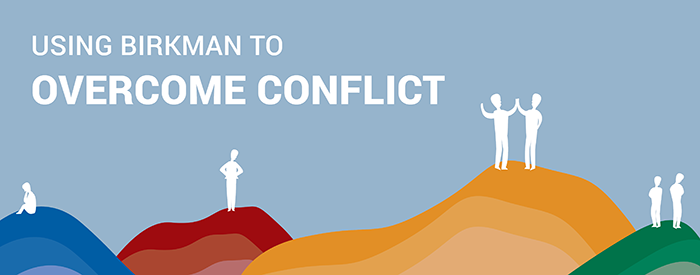
Conflict is something that appears in every relationship, whether it be personal or professional. In the work setting, it can either be a hindrance to performance and productivity or a catalyst for positive change and strengthened relationships. Disagreements bring about opportunities to learn about coworkers—what makes them tick and ways to bring out their best. From an individual level (identifying stressors) to an interpersonal level (building stronger relationships), let's talk about ways to not just overcome conflict, but to grow from it through understanding personality.
|
Understanding Stress in Conflict
|
Stress is often the underlying cause of conflict, so it's important to recognize the symptoms of stress. There are three facets of stress to understand when working through disagreements with others. These are:
- Recognizing when someone is stressed (signs of Stress Behavior)
- Understanding what may be causing them stress (not having Needs met)
- Knowing how to help them manage stress to return to their Usual Behavior by meeting their Needs
Everyone has preferences for their work environment, such as a high structured or a flexible approach to tasks. These preferences are captured in our internal Needs—what we expect from our environment and others. Needs are important because when they aren't met over a period of time, people can go into Stress Behaviors—unproductive, reactionary behaviors that are not conducive to solving conflict.
There are different signs to tell if someone is stressed and actions they can take to help pull them out of it:
| |

RED
IMPATIENT
|

GREEN
INTENSE
|

BLUE
SAD
|

YELLOW
RIGID
|
|
Stress Behavior signs:
(pg 11 of the Basics Report)
|
May become impatient, dismiss others' feelings, be busy for the sake of being busy |
May become easily distracted, distrust others, fail to follow the plan |
May become discouraged, indecisive, find it hard to take action |
May become rigid and overly insistent on rules, resistant to change, anxious about the unpredictable |
| When stressed, it may help to: |
Make time to reflect, make plans, visualize possibilities, generate ideas, innovate |
Schedule activities, pay attention to details, try to follow policies and procedures |
Worry less about making the perfect decision, try to take direct actions and solve problems |
Engage with people and try to be more flexible |
When resolving conflict between two coworkers or a team, note that:
- When stressed, working with someone who displays Stress Behavior diagonal on the Birkman Map from you usually exacerbates the situation. If coworkers with opposing colors are having a disagreement, it's helpful to sit them down and have a discussion about their opposing tendencies. This can encourage them to not take these behavioral tendencies personally and seek reconciliation.
- Even though people displaying opposite Stress Behaviors may clash in a disagreement, what will help them overcome conflict and become effective is to tap into the productive behavior of the opposing color. For example, someone with Blue Stress Behavior needs to worry less about coming to the perfect decision and focus more on taking action, borrowing this behavior from a Red.
Now that we've talked about understanding people and their different Stress Behaviors, mitigate conflict before it starts by having ongoing conversations about personality with your team. We talked about exploring Stress Behavior with your peers, but it's helpful to dive into different behavioral facets, like Usual Behavior and Needs as well. When people have a well-rounded understanding of their teammates, interpersonal conflicts and miscommunications are less likely to arise.
Drive awareness in your team with ongoing activities using the Birkman at Work toolkits, effective and memorable workshops that require minimal effort on your end!
Explore the entire collection of workshop toolkits!
|
.png?width=400&upscale=true&name=Horizontal%20Logo%20RGB%20(1).png)










